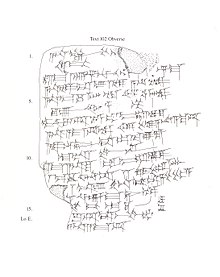
Amarna letters
The Amarna letters (/əˈmɑːrnə/; sometimes referred to as the Amarna correspondence or Amarna tablets, and cited with the abbreviation EA, for "El Amarna") are an archive, written on clay tablets, primarily consisting of diplomatic correspondence between the Egyptian administration and its representatives in Canaan and Amurru, or neighboring kingdom leaders, during the New Kingdom, spanning a period of no more than thirty years between c. 1360–1332 BC (see here for dates).[1] The letters were found in Upper Egypt at el-Amarna, the modern name for the ancient Egyptian capital of Akhetaten, founded by pharaoh Akhenaten (1350s–1330s BC) during the Eighteenth Dynasty of Egypt.
The Amarna letters are unusual in Egyptological research, because they are written not in the language of ancient Egypt, but in cuneiform, the writing system of ancient Mesopotamia. Most are in a variety of Akkadian sometimes characterised as a mixed language, Canaanite-Akkadian;[2] one especially long letter—abbreviated EA 24—was written in a late dialect of Hurrian, and is the longest contiguous text known to survive in that language.
The known tablets total 382, of which 358 have been published by the Norwegian Assyriologist Jørgen Alexander Knudtzon in his work, Die El-Amarna-Tafeln, which came out in two volumes (1907 and 1915) and remains the standard edition to this day.[2][3] The texts of the remaining 24 complete or fragmentary tablets excavated since Knudtzon have also been made available.[2]
The Amarna letters are of great significance for biblical studies as well as Semitic linguistics because they shed light on the culture and language of the Canaanite peoples in this time period. Though most are written in Akkadian, the Akkadian of the letters is heavily colored by the mother tongue of their writers, who probably spoke an early form of Proto-Canaanite, the language(s) which would later evolve into the daughter languages of Hebrew and Phoenician. These "Canaanisms" provide valuable insights into the proto-stage of those languages several centuries prior to their first actual manifestation.[4][5]
Amarna letter EA 15, from Ashur-uballit I; see also Amarna letter EA 153.



